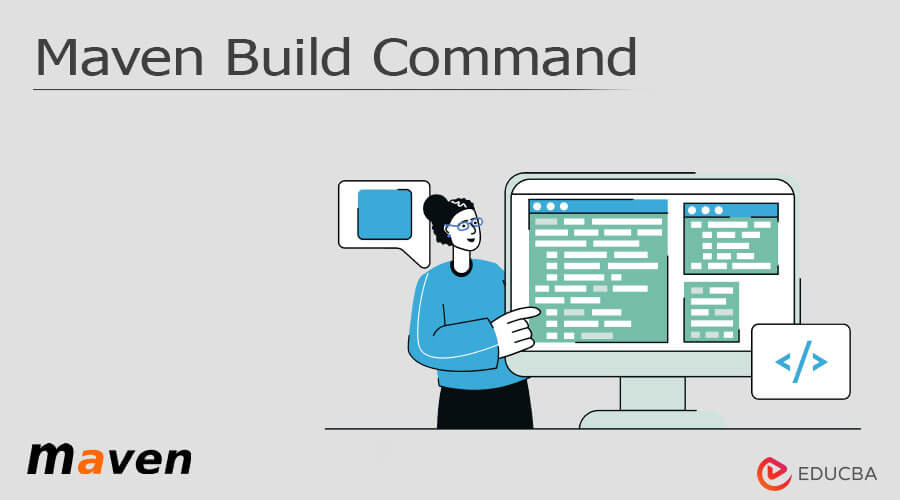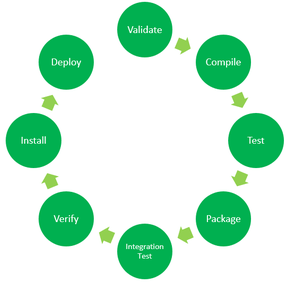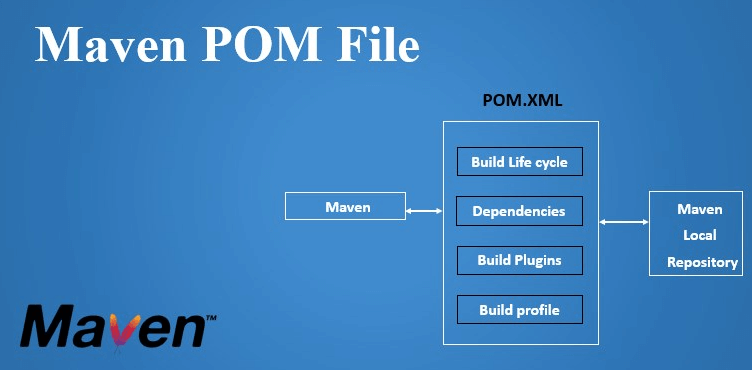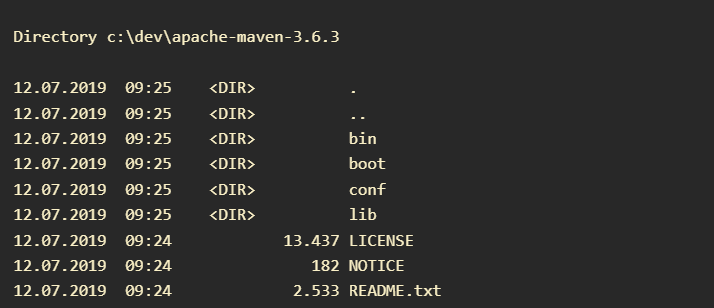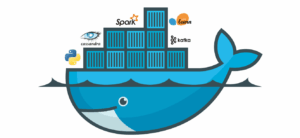Maven is a tool for automating the build process that has a large number of commands available through the command line interface (CLI). They give you the ability to manage project dependencies, create reports, and more while compiling, testing, packaging, and deploying your applications.
When these operations are carried out mechanically rather than by a human, the construction is more dependable, speedier, and less prone to error.
So let’s find out more about Maven’s functionality, capabilities, and commands.
Describe Maven.
The Apache Group created the well-known Apache Maven open-source build tool to build, publish, and deploy several projects for better project management.
With the Java project tool, Maven, you may establish a Maven project in C#, Scala, and Ruby. This tool has made it easier for Java developers to write reports, review build phases, and test automated settings. It is based on the POM.
By taking care of the following, Apache Maven focuses on streamlining and standardising the requirements for developing projects:
-
-
- Develop phase
- Documentation
- Examining the dependencies of a snapshot
- Report
- SCMs
- Distribution
- Releases
- Contact list
-
Maven’s key characteristics go a long way toward explaining why it is so popular. Apache Maven is your way to construct Java projects and has a tonne of fantastic capabilities.
Here are some of the Maven’s standout characteristics:
-
-
- There are user library transitive dependencies accessible.
- Ability to launch projects rapidly using best practices
- Managing dependencies with automated updates
- Compatibility with Maven’s prior iteration
- Robust error reporting and integration testing
- Visioning of parents automatically
- Consistent applicability across all projects is ensured
- The default setting
- Expandable compiler plugin that will compile the source code of the Maven project for you
-
The local system, the internet, or open repositories can all be utilized to source dependencies. The Maven Central Java library repository is the default place to seek for required libraries.
The local Maven repository is located in the user’s home directory structure, and Maven uses this directory as a temporary storage site for downloaded files.
What Is the Way Maven Works?
Maven’s core concept is the building life cycle. This shows that particular project development and distribution procedures are clearly established.
This implies that in order to create any Maven project, the person creating it must learn a few maven commands, and the POM will make sure they get the results they want.
Preinstalled are default, clean, and site-build lifecycles.
-
-
- Your project’s deployment is handled by Default.
- Your project’s cleanup is handled by Clean.
- The website manages website creation for your project.
-
Each build lifecycle is defined by a different list of phases, where a build phase corresponds to a point in the lifecycle.
-
-
- Validate: Examines the project’s accuracy and the availability of the required data.f
- Test: Before conducting a test, the project source code must be compliant by utilizing a suitable unit testing framework.
- Package: packages the compiled code into a distributable format.
- Verify: Checks the outcomes of the integration tests to make sure that the requirements for quality are met.
- Install: To use the package locally as a dependency in other projects, install it into the local repository.
- Share: the finished package with other developers and projects by deploying the process. The built environment is where it is finished.
-
The Build Lifecycle Is Made Composed of Plugin Objectives.
A phase is responsible for a specific stage of the build lifecycle, albeit the manner in which it does so can vary. This is achieved by declaring the plugin goals related to those phases.
A plugin goal is a planned action that facilitates project creation and management (even more precise than a build process). It might be connected to zero phases or more.
Goal execution outside of the build lifecycle is possible by direct invocation of a goal that is not linked to any phase. The phases and goals are called in a specific order, which determines how they will be carried out.
Furthermore, if a goal is connected to one or more phases, those phases will collectively make a call to the goal.
Moreover, a phase may have zero or more goals connected with it. If a phase doesn’t have any goals associated with it, it won’t run. Nonetheless, it will accomplish those aims if it is linked to one or more of them.
What is the need for Maven?
Maven is mainly used for Java projects when downloading dependencies, which are libraries or JAR files. The program then obtains the correct JAR file for each project since there may be multiple versions of different packages after taking the compiled code and packaging.
Once Maven is set up, it is no longer essential to visit the official websites of various pieces of software in order to install dependencies. You can locate libraries in different languages by using the maven command. The tool helps create the proper project structure in struts, servlets, etc., which is essential for execution, together with the Maven wrapper.
-
-
- Moreover, you can benefit from Maven in the following areas:
- Makes it easier to administer all project management procedures
- Improves the efficiency of both the construction process and the project.
- JAR file is automatically downloaded to the remote repository.
- Quick access to all relevant information is made possible.
- Ensures that the developer can build a project in a variety of scenarios without worrying about dependencies or workflows
- It is simple to add new dependencies to Maven projects after the JUnit dependency has been added by entering the code in the POM file.
-
How Is Maven Related to Project Object Model (POM)?
Maven is helpful for everyone because POM is an XML file that contains all the project and configuration parameter data. The POM contains information on the project’s description, versioning, and configuration management.
When you do a task, Maven searches the project home directory for the POM, where you can locate your file.
A collection of IDs that Maven coordinates can also be used to specifically identify plugins or project dependencies in a Maven POM.
Downloading Maven
The task of installing Maven is rather straightforward. The Java release you are aiming for is simply a zip file that you need to download and install anywhere on your hardware. This is the content of the.zip file.
The /bin directory must now be added to your PATH setting. Otherwise, you are unable to call “mvn” from any location. I’m done now.
Also, use the following command line to open a terminal and confirm that Maven was properly installed.
mvn -versionFeedback on the version of Maven you have installed should be the output. You have now successfully installed Maven.
You can begin the Maven build phases to create a project after a successful installation.
Maven Project Development Stages
The procedures to create a Maven project are as follows. Maven enables multi-module projects running with a continuous integration tool.
-
-
- Step 1: Creating an application is coding it, adding or writing it, and then processing it into the source code git repository.
- Step 2: Enter the entire Java project source code and make any necessary changes to the configuration project POM, XML, or plugin information.
- Step 3: Build the software in step three.
- Step 4: Send the outcomes of your build process to a local server or another location, such as a WAR or EAR file, in step 4.
- Step 5: Access the file locally or remotely to deploy it to the client or the production site.
- Step 6: If required, update the application version number and date in the document.
- Step 7: Create and produce a report in accordance with the requirements or the applications’ specifications.
-
Overview of Maven Commands
To save time and avoid having to download data from the internet each time you use Maven commands, Maven stores all of the information it downloads in a local repository.
Consider it a cache; Maven examines the remote repositories for items needed to run command lines but not yet in the local maven repository.
The local repository is often located in the m2 directory. Also, that directory has the settings XML file, which acts as the Maven setup for the remote repository. Access credentials, remote repository setup, and other things can be done with it.
Declarative Maven Command
You can describe what your command builds without explicitly stating what to do because Maven is a declarative build system.
For instance, you can use a maven-compiler plugin to configure the build so that the Java sources are compiled, but you are unable to establish a certain time for Maven to run the build.
The project model is specified in the Java source code and POM file, which is where Maven obtains the necessary configuration data to function. They include the plugins that need to be used, the build settings, and tools for managing declared dependencies.
Maven plugin functionality is divided into building-block-like goals. The goals are registered to be completed during all build phases.
The goals do the actual work during the phases that follow the project’s lifespan.
Overview of Maven Options
The command line parameters can be used to configure and personalize Maven builds. You can facilitate or speed up your work with Maven command line arguments in addition to learning about the entire Maven build lifecycle and what plugins are available.
Basic Maven Options and Commands [Status Sheet]
Maven is quite trustworthy and has a wide range of plugins that can help with producing PDF versions and lists of any most current changes that have been made.
Since every other command maven project contains a POM and an XML, it is straightforward. Also, Maven makes any migration of new features straightforward.
Let’s examine the Maven commands that are used the most!
#1: mvn version
The mvn command line tells us what version of Maven is installed.
mvn -vMoreover, you should use the Maven command listed below to create a project utilizing MVN architecture.
mvn archetype:generate -DgroupId=com.mycompany.app -DartifactId=my-app -DarchetypeArtifactId=maven-archetype-quickstart -DarchetypeVersion=1.4 -DinteractiveMode=falseArchetypes are a term for Maven-based templates. Maven will acquire all archetypes, including the maven archetype quickstart, using the command described above.
Also, it will finalize all settings and produce a finished good.
#2: Mvn package
All Maven phases up until the package phase are run with this command. The project is built, verified, and compiled using the mvn package.
The mvn package also produces the JAR file and stores it in a certain folder underneath a particular folder.
mvn package#3: mvn clean install
This Maven command line installs the build phase in the usual build cycle and assists in carrying out a clean build lifecycle. There may be multiple build goals inside each development phase of this build lifecycle.
mvn clean installMoreover, the mvn clean install command adds the mvn clean install target and guarantees that the build target is deleted for a new build.
#4: mvn compile
The source code is compiled using the Maven command: mvn compile. The mvn compile also compiles the classes that are saved at a specific target or class.
The mvn compile command executes the whole Maven life cycle up to compile, unlike the prior mvn compiler: compile command. Along with the Maven compiler plugin, the Java files can be converted into class files.
mvn compile#5: mvn test
The target directory is cleaned by this maven command, which also offers the option of unit testing certain codes. The mvn test command line option, therefore, executes the tests using the appropriate testing frameworks.
Create a Maven run configuration for a single test command using this if you want to run a test on a single test in your project.
mvn test#6: mvn deploy
Deploying the project’s code is another feature of Maven. An integration or release environment is used for this deployment.
It becomes accessible for sharing with other developers after copying all final packages to the remote repository.
mvn deploy#7: mvn site
Based on the data in the project’s pom, this Maven command line creates a website. The created document, which is visible under the target or the site, is executed by Maven.
mvn site#8: mvn validate
This Maven command verifies the project to make sure everything is accurate and the required data is present.
Before running verify, the command runs each lifecycle phase in sequence. The final phase, which must be called in order to be carried out, occasionally resembles the mvn package command.
mvn validate#9: Mvn dependency tree
This Maven command creates a tree-based view of a specified Maven project. If you wish to acquire the dependency tree for your project, you must type the command into the terminal.
mvn dependency tree#10: mvn dependency analyzer
This command line examines the Maven project to find any undeclared dependencies that have been used but not declared.
By locating the unnecessary dependencies and eliminating them from the XML and pom files, also aids in reducing the build size.
mvn dependency analyze#11: mvn clean package
The target directory is cleaned up by the mvn clean package command. Without running unit tests during the build, the project is built and packaged in the resulting JAR file into the target directory.
mvn clean package#12: The mvn archetype produces
This Maven command line creates a skeleton for projects of several types, including JAR, Maven websites, and website applications.
mvn archetype generate#13: mvn verify
To make sure the quality requirements are met, this Maven command builds projects, executes all test cases, and performs any checks on the findings of the integration tests.
mvn verify#14: mvn install
While creating a Maven project, the command mvn install installs all project files to the local repository, including JAR, WAR, and POM files.
mvn install#15: mvn q package
With this command-line option, just the test case results and problems are displayed during the Maven build.
mvn q package#16: mvn x package
This command-line option performs the build in debug mode so that all messages are displayed when printing the Maven version information.
mvn x package#17: is mvn clean.
The project is cleaned and rebuilt using the mvn clean command. A clean build life cycle based on the plugin aim clean: clean is done by the mvn clean command.
mvn cleanConclusion
Maven is one of the greatest tools for developing, testing, and deploying straightforward Java projects. In a single tool, it offers stronger builds, improved debugging, and increased collaboration at every stage.
The more consistent project structure of Maven commands helps to reduce redundancy. Better hierarchical dependency trees containing all transitive dependencies and improved dependency management are the end results of using Maven commands and options.
Maven is one of the finest options out of all the tools that are accessible.

